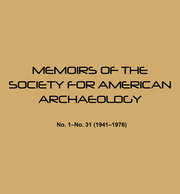No CrossRef data available.
Article contents
Site Summaries
Published online by Cambridge University Press: 27 June 2018
Extract
Before turning to a systematic description of the archaeological sites of the Columbia-Fraser region, it will be well to review briefly the main sources of information. It may then be possible to bring together various of the sites and, with considerable tentativeness to be sure, associate them according to the cultural phases they represent. Some framework for the prehistory of the region may thus be obtained.
Judge Wickersham's early data for western Washington led him to believe that it was a poor region “for the development of the Stone Age,” and that the Indian “made his implements of bone, shell, or wood, and these soon decayed.” He goes on, however, to mention mauls, adz blades, clubs, and pipes of polished stone, in addition to chipped points among which “ … local forms are rare, but so distinct in character from others, which are so clearly traced to eastern Washington, as to admit of but little doubt as to their local origin.” He apparently thought the archaeological materials were closely related to the objects used by living Indians. Ties between the peoples east and west of the Cascades were obvious on the ethnological level and Wickersham was, consequently, not surprised to find arrow points on the Sound which were reminiscent of the eastern section of the state.
- Type
- Research Article
- Information
- Copyright
- Copyright © Society for American Archaeology 1950
References
1 Wickersham, 1900, p. 141.
2 Ibid., p. 145.
3 H. I. Smith, 1904a, p. 437. See also p. 308.
4 Ibid., p. 439.
5 Ibid., p. 440.
6 Ibid., p. 441.
7 In H. I. Smith, 19006, pp. 387-9. See also Kroeber, 1923, p. 17.
8 In H. I. Smith, 1904a, p. 433.
9 Reagan, 1917, p. 18.
10 Ibid., p. 20.
11 Ibid., pp. 21-3.
12 Ibid., pp. 30-1.
13 Ibid., p. 24.
14 Ibid., p. 30.
15 Hill-Tout, 1938, p. 7.
16 Menzies, 1938, p. 360.
17 Lentherman and Krieger, 1940, p.21.
18 Ibid., p. 20.
19 Strong, Schenck, and Steward, 1930, p. 140.
20 Ibid., pp. 89-90; Steward, 1928.
21 Ibid., p. 52.
22 Ibid., p. 68 and Tables 1-6. Cf. conclusion, p. 142.
23 Ibid., Table 3, p. 74.
24 Ibid., p. 142 ; see also Table 6, p. 91.
25 Ibid., p. 107; Table 6, p. 91.
20 Ibid., p. 138.
27 Ibid., p. 139.
28 Ibid., p. 140.
29 Ibid., p. 142.
30 Ibid., pp. 143-4.
31 See, for instance, Krieger, 1931, p. 534.
32 Strong, 1945.
33 For instance, Heizer, 1942; Hill-Tout, 1935; Seaman, 1946; H. I. Smith, 1904a, 19046, 1917, 1923; M. W. Smith, 1943, 1946; Terry, 1891; Thomas, 1897. Local antique dealers in Vancouver, B.C., have recently had a number of “ancient” carved stone heads for sale.
34 H. I. Smith, 19006, Fig. 380 and p. 431.
35 M. W. Smith, 1946.
36 Hill-Tout, 1932; Matier, 1936; Milligan, 1933, 1937; Robinson, 1935; H. B. Smith, 1933; and St. John, 1933, 1934.
37 Boas, 1904; H. I. Smith, 1908.
38 Wingert, 1949a, 1949b. For further corroboration of the same point see Herzog, 1949.
39 Codere (1948) has already demonstrated the vitality of a Middle Fraser tradition, although in quite different materials. See also Drucker, 1948.
40 M. W. Smith, 1940b, pp. 199, 266, 295-6, 321-3.
41 H. I. Smith, 1904a.
42 Haeberlin and Gunther, 1930, pp. 26-8.
43 Gibbs, 1877, pp. 175, 192, 214.
44 Stern, 1934, p. 49.
45 Gunther, 1927, p. 204.
46 Olson, 1936, pp. 75-6, 78.
47 Ray, 1938, p. 135.
48 Leatherman and Krieger, 1940, p. 21.
49 Reagan, 1928, p. 297.
50 H. I. Smith, 1904a.
51 Reagan, 1917, p. 10.
52 Ibid., p. 9.
53 Leatherman and Krieger, 1940.
54 Hill-Tout, 1895; Reagan, 1917, p. 29.
55 Hill-Tout, 1895, pp. 112-3.
56 Hill-Tout, 1932 and 1938; Hill-Tout and Kidder, 1932.
57 Menzies, 1938, p. 360. Also noted by H. I. Smith, 1904a, p. 434.
58 Menzies, 1938, p. 360.
59 Robinson, 1935.
60 Hill-Tout, 1932 and 1938.
61 H. I. Smith, 1899b.
62 Hill-Tout, 1932, p. 104; Reagan, 1917, p. 30; Menzies, 1938, p. 360.
63 Reagan, 1917, pp. 24, 30.
64 Hill-Tout, 1938, p. 7.
65 Menzies, 1938, pp. 360-1.
66 See also discussion of carving above.
67 H. I. Smith, 1906a, 1908, etc.
68 H. I. Smith, 1908, p. 776.
69 Reagan, 1917, p. 18.
70 Strong, Schenck, and Steward, 1930, p. 99.
71 Ibid., p. 147.
72 Ibid.
73 Laughlin, 1941; 1942.
74 Laughlin, 1941, pp. 151-2.
75 Leatherman and Krieger, 1940, pp. 27-8.
76 Barnett, 1037.
77 Ibid., p. 194.
78 At least tentatively I am classifying the “pear-shaped maul” cited for historic Tolowa by Barnett as a pestle. The whole distinction between mauls and pestles is mainly functional and highly inaccurate. However, the mauls are taken here as being consistently large, heavy, worked stones suitable for advanced woodwork; pestles are lighter and used frequently for food stuffs. The distinction holds ethnologically. Unworked hammerstones replace mauls in some Coastal Stone south of the Columbia but information on these unspectacular specimens does not warrant their inclusion in trait lists at the present.
79 In H. I. Smith, 1904a.
80 Ibid., p. 380.
81 King, 1949, 1950.
82 Reagan, 1917, p. 11.
83 Wickersham, 1900, p. 146: “… in Washington they [pipes] are quite plain, though highly polished. Few are found along the coast or on Puget Sound; many more are found on the midland prairie… .” According to Sam Wilson, the Suquamish of the historic period used a pipe “of black polished rock which they got from the Yakimas.” After the coming of the whites, the Snohomish (?) “obtained black stone pipes from the Klikitat” (Haeberlin and Gunther, 1930, p. 66).
84 Goddard, 1945, p. 36.
85 Kroeber, 1923, p. 8.


